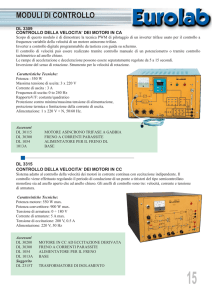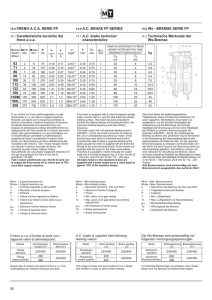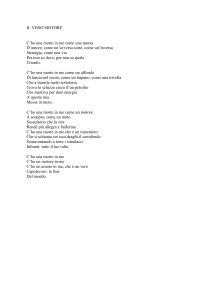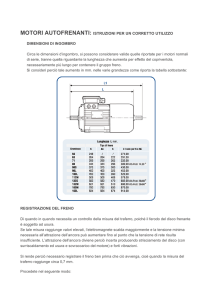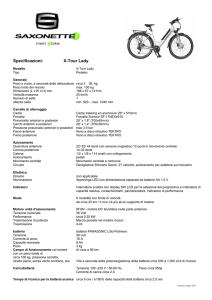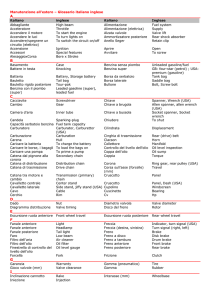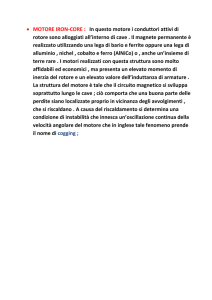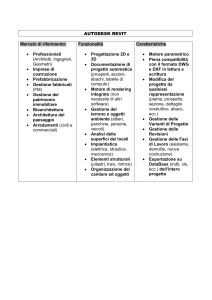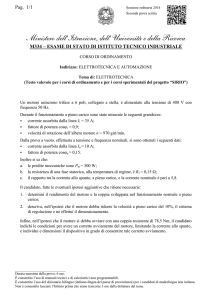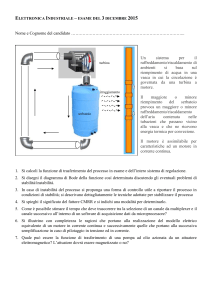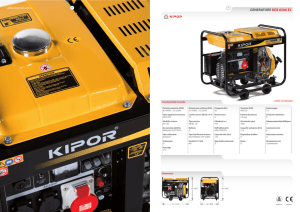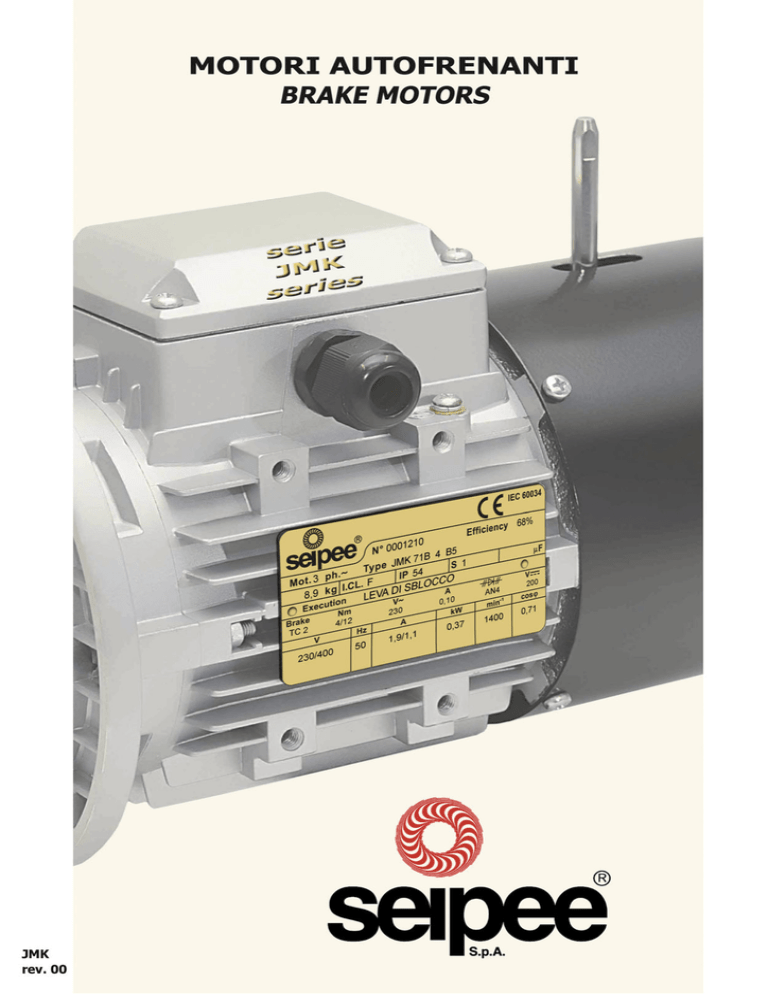
Avvertenza importante
Important Notice
Tutte le descrizioni e i dati riportati nel presente catalogo
non sono impegnativi e ci riserviamo il diritto di modificarli
senza darne preavviso. Per particolari informazioni
tecniche si prega di farne richiesta al nostro ufficio.
Texts and data of this catalogue are not binding and we
reserve the right to change them without previous notice.
For any further technical information please do not hesitate
to contact us.
JMK
INDICE CATALOGO
CATALOGUE INDEX
CARATTERISTICHE GENERALI .......................................... 4
GENERAL SPECIFICATIONS ............................................ 4
POTENZE E DATI ELETTTRICI ........................................... 6
POWERS AND ELECTRIC DATA .................................... 6
TOLLERANZE CARATTERISTICHE ELETTRICHE – EN
TOLERANCES NOMINAL SPECIFICATIONS EN 60034-1 . 9
60034-1 ............................................................................... 9
DIMENSIONS JMK 63 ...160 ............................................ 10
DIMENSIONI JMK 63 ... 160 ............................................. 10
DIMENSIONS JMK 63 ...160 ............................................ 11
DIMENSIONI JMK 63 ... 160 ............................................. 11
BEARINGS AND LOADS .................................................. 12
CUSCINETTI E CARICHI ................................................... 12
GENERAL SPECIFICATIONS OF BRAKES ..................... 13
CARATTERISTICHE GENERALI DEI FRENI ...................... 13
SPECIFICATIONS OF THE BRAKE A.C. ......................... 14
CARATTERISTICHE FRENI IN C.A. ................................ 14
SPECIFICATIONS OF THE BRAKES D.C. ..................... 14
CARATTERISTICHE FRENI IN C.C. ................................ 14
SERIES TA, GA ............................................................... 15
SERIE TA, GA .................................................................. 15
SERIES TC, GC ............................................................... 16
SERIE TC, GC .................................................................. 16
INTORQ BRAKE SERIES L7, L8 ...................................... 17
FRENI INTORQ SERIE L7, L8 .......................................... 17
SPECIAL EXECUTIONS AND ACCESSORIES ............... 18
ESECUZIONI SPECIALI E ACCESSORI ........................... 18
INSTALLATION AND MAINTENANCE ............................ 21
INSTALLAZIONE E MANUTENZIONE ................................ 21
COMMUNITY DIRECTIVES .............................................. 23
DIRETTIVE COMUNITARIE ............................................... 23
CONNECTION SCHEME TERMINAL BOX THREE PHASE
SCHEMA COLLEGAMENTO MORSETTIERA MOTORE
MOTOR 2, 4, 6, 8 POLES ................................................. 24
TRIFASE 2,4,6,8 POLI ...................................................... 24
CONNECTION OF THE A.C. BRAKE SERIES TA, GA .... 24
COLLEGAMENTO FRENO A CORRENTE ALTERNATA
CONNECTION OF THE D.C. BRAKE TYPE TC, GC, L7, L8
SERIE TA, GA .................................................................. 24
......................................................................................... 25
COLLEGAMENTO FRENO A CORRENTE CONTINUA SERIE
PERIODICAL MOTOR MAINTENANCE ............................ 28
TC, GC, L7, L8 .................................................................. 25
AIR GAP ADJUSTMENT .................................................. 28
MANUTENZIONE PERIODICA DEI FRENI ......................... 28
SPARE PARTS OF THE BRAKE ...................................... 29
REGOLAZIONE DEL TRAFERRO ..................................... 28
MAIN TECHNICAL STANDARDS APPLIED ...................... 30
PARTI DI RICAMBIO FRENI .............................................. 29
NAME PLATE ................................................................... 31
PRINCIPALI NORME TECNICHE APPLICATE ................... 30
TARGA D’IDENTIFICAZIONE ............................................. 31
rev. 00
P. 3
JMK
CARATTERISTICHE GENERALI
GENERAL SPECIFICATIONS
Serie JMK
JMK series
IEC 63…160; 0,12…18.5 kW; 2 , 4 , 6 , 8 poli
in 3 versioni:
- con freno in corrente alternata: serie TA… , GA…
- con freno in corrente continua: serie TC… , GC…
- con freno in corrente continua Intorq: serie L7… , L8…
Motore elettrico autofrenante asincrono trifase normalizzato per
uso generale in applicazioni industriali, con rotore a gabbia in
corto circuito, chiuso, autoventilato esternamente (metodo di
raffreddamento IC 411), classe termica d’isolamento F
(sovratemperatura motore classe B).
Progettato per operare in servizio continuo (S1) a tensione e
frequenza nominali.
Temperatura aria ambiente di lavoro: –15 ÷ +40 °C.
Altitudine massima: 1000 m sul livello del mare.
IEC 63…160; 0,12…18,5 kW; 2, 4, 6, 8 poles - single speed
in 3 types:
- with alternating current brake: AC brake series TA…, GA…
- with direct current brake: DC brake series TC…, GC…
- with Intorq direct current brake: series L7…,L8…
Standard asynchronous three-phase brake motor with short
circuit squirrel-cage rotor, for general purposes in industrial
applications. Totally enclosed, externally fan–cooled (method
of cooling IC 411), thermal insulation class F (motor-temperature rise class B).
Motor designed to work in continuous running duty (S1) at rated
voltage and frequency.
Ambient air temperature: –15 ÷ +40 °C.
Maximum altitude: 1000 m above sea level.
I motori JMK 2 poli e 4 poli, unificati, autoventilati,
con potenze normalizzate maggiori o uguali ad 1,1 kW, appartengono alla classe di efficienza 2, nata dall’accordo volontario per la protezione dell’ambiente tra CEMEP (Comitato europeo costruttori macchine rotanti e elettronica di potenza) e
Commissione Europea.
Per questo motivo, i motori JMK riportano in targa il logo depositato e registrato.
Grado di protezione:
involucro motore IP 55;
involucro freno standard IP 54. A richiesta grado di protezione
IP55 solo serie TA, GA (non possibile in esecuzione con leva
di sblocco).
Forme costruttive IM B3, IM B5, IM B14 e forme combinate
IM B35 (B3/B5) e IM B34 (B3/B14).
I motori possono funzionare anche nelle corrispondenti forme
costruttive ad asse verticale, ma al momento della richiesta
del motore occorre specificarne il posizionamento esatto.
Sulla targa del motore rimane indicata la forma costruttiva ad
asse orizzontale.
Carcassa in lega leggera d’alluminio pressofusa. Ottima
conducibilità termica, eccellente resistenza alla corrosione.
Anello di sollevamento a partire dalla grandezza 100.
Scudi e flange
Scudo o flangia lato accoppiamento in lega leggera d’alluminio
pressofusa, sedi dei cuscinetti rinforzate in acciaio grandezze
80 … 160. Scudo lato opposto accoppiamento in ghisa.
Scudi e flange sono tutti con attacchi di serraggio “in appoggio” e montati sulla carcassa con accoppiamento “stretto”.
Piedi in alluminio. Possibilità di montare i piedi sui 3 lati del
motore al fine di avere la scatola morsettiera sul lato desiderato:
IM B3, B5, B35, B14, B34 / R, B, L, T.
Di serie il motore IM B3 è fornito con scatola morsettiera in alto
(posizione T).
P. 4
motors JMK 2 and 4 poles standard, fan-cooled
Standard 2 poles and 4 poles, fan-cooled motors of output
power equal to 1.1 kW or more belong to EFFICIENCY class 2.
Efficiency class 2 was created by the voluntary agreement for
environmental protection between CEMEP (European
Committee of Manufacturers of Electrical Machines and Power
Electronics) and European Commission.
Therefore, on the name plate of JMK motors, it is stated the
registered mark.
Protection degree
Protection-degree of the motor-enclosure IP 55;
Protection-degree of the brake-enclosure IP 54. At request
protection – degree IP55 on series TA,GA
( not available with hand release lever).
Types of construction IM B3, IM B5, IM B14 and combined
types IM B35 (B3/B5) and IM B34 (B3/B14).
Motors can also work in the corresponding types of construction
with vertical shaft, when inquiring please exactly state the final
mounting arrangement of the motor.
Only the horizontal type of construction will be indicated on the
name plate of the motor.
Housing in die-cast aluminium light alloy, with the best thermal
conductivity and an exceptional resistance to corrosion.
Hoisting ring from size 100.
Shields and flanges
Drive-end shield or flange in die-cast aluminium light alloy,
bearing-bores reinforced with steel sizes 80 … 160. Non-driveend shield in cast-iron.
All shields and flanges are with “supported” tightening
attachments and are fitted on housing with a “tight” coupling.
Aluminium feet can be detached and fixed on each one of
the three motor-sides so to position the terminal-box on the
required side:
IM B3, B5, B35, B14, B34 / R, B, L, T.
Standard IM B3 motor has the terminal box on the top of the
housing (T position).
rev. 00
JMK
Scatola morsettiera e coperchio coprimorsettiera in lega leggera d’alluminio pressofusa (protezione IP 55), con accesso
cavi bilaterale dalla grandezza 63 … 132: (grandezze 63 … 80
un foro per parte, pressacavo lato destro e tappo lato sinistro;
grandezze 90 … 132 due fori per parte, due pressacavi lato
destro e due tappi lato sinistro). Nella grandezza 160 standard
due pressacavi lato destro, a richiesta lato sinistro.
Morsetto di terra all’interno della scatola morsettiera;
predisposizione per un secondo morsetto di terra sulla carcassa.
Morsettiera per alimentazione motore a 6 morsetti.
Alimentazione freno separata : serie TA, GA con morsettiera
ausiliaria, serie TC, GC, L7, L8 con raddrizzatore entrambi
posizionati all’interno della scatola morsettiera motore. Per
collegamento freno vedere “Installazione e manutenzione freni”.
Cuscinetti radiali rigidi a sfere ad una corona, doppio schermo
lubrificati a vita, delle migliori marche e selezionati per l’uso
specifico sui motori elettrici.
Albero motore in acciaio al carbonio con estremità cilindriche,
foro filettato in testa e linguetta unificati; albero motore bloccato assialmente mediante due anelli elastici (uno sull’albero,
l’altro sullo scudo posteriore).
Ventola di raffreddamento calettata sull’albero motore,
bidirezionale a pale radiali, in materiale plastico resistente alle
alte temperature.
Avvolgimento statorico realizzato mediante filo di rame in
classe H a doppio smalto. Sistema di impregnazione con resine di alta qualità in classe H.
Accurata separazione degli avvolgimenti di fase (in cava e in
testata), accurato isolamento della “trecciola” (cavi di inizio fase).
Gli altri materiali sono in classe F o H. Il sistema d’isolamento
complessivo è in classe F.
Materiali utilizzati e tipo di impregnazione consentono l’impiego in clima tropicale senza ulteriori trattamenti.
Rotore a gabbia di scoiattolo in corto circuito in alluminio
pressofuso.
Equilibratura dinamica rotore con mezza linguetta inserita
nell’estremità dell’albero.
Intensità delle vibrazioni meccaniche: grado di vibrazione “N”.
(Valori efficaci massimi: grandezza motore 63 … 132 1.8 [mm
/ s], 160 2.8 [mm / s] ).
Verniciatura: motore verniciato con smalto nitrocombinato di
colore “grigio alluminio” (RAL 9006), idoneo a resistere ai normali ambienti industriali e a consentire ulteriori finiture con vernici sintetiche monocomponente.
Copriventola (coprifreno) in lamiera di acciaio, di colore nero,
verniciato a polvere sia internamente che esternamente.
Caratteristiche freni e le relative istruzioni d’installazione e di
manutenzione vedere capitolo “ Installazione e manutenzione “.
Funzionamento con inverter
I motori della serie JMK sono adatti al funzionamento con
inverter. Ampia disponibilità di esecuzioni, servoventilazione,
encoder, sonde termiche bimetalliche o a termistori, ecc. (vedere “esecuzioni speciali e accessori).
rev. 00
Terminal-box and terminal-box cover in die-cast aluminium
light alloy ( protection IP55),
Supply-cable inlet bilateral sizes 63 … 132 ( sizes 63 … 80
one hole on each side, cable gland on right side and cap on
the left side; sizes 90 … 132 two holes each side, two cable
glands on right side and two caps on the left side). On size 160
two cable glands standard on the right side, at request on the
left side.
Earth-terminal is positioned inside the terminal box;
prearrangement for a second earth-terminal on the housing.
Terminal-block for motor-supply has 6 studs.
Standard supply of the brake separate from the one of the
motor. Series TA, GA with auxiliary terminal box, series TC,
GC, L7, L8 with rectifier. Both positioned inside the terminal
box of the motor.
For brake-connection please see “Installation and maintenance
of brakes”.
Bearings: stiff, radial, single-crowned, double-shielded (ZZ) ballbearings with life-long lubrication. Made by the best
manufacturers and selected for the specific use on electric
motors.
Carbon-steel driving shaft: standardized cylindrical ends,
shaft-head threaded centre-hole and key.
The driving shaft is axially fastened by means of two elastic
rings (one on the shaft and one on the rear shield).
Cooling fan is a bi-directional, radial-vane fan in resistant to
high temperatures plastic material and is tightly fixed to the
motor-shaft.
Stator-winding is made with double-coated class-H copperwire. Impregnation-system made with high-quality class-H resins.
Accurate insulation of phase-windings (in each slot and on the
winding-top), accurate insulation of the winding-leads (phasebeginning leads). Other insulating materials are in class F or
H. Final insulating system of the complete motor is in class F.
Materials and type of impregnation allow use in tropical climates
without further treatments.
Rotor: short circuit squirrel-cage rotor in pressure die-cast
aluminium.
Dynamic rotor balancing with a half key fitting in the driving
shaft.
Intensity of mechanical vibrations: Vibration grade “N”.
( Maximum values: size 63…132 1.8 [mm / s], 160 2.8 [mm /
s]).
Painting: Motors are painted with nitro-combined “aluminium
grey” colour (RAL 9006 shade), suitable for normal industrial
environment and unaffected by further finishing with singlecompound synthetic paints.
Steel-sheet Fan-cover (brake-cover) black painted, both on
the outside and the inside, by powder-painting system.
Brake specifications: please look further ahead for technical
specifications, “installation-instructions and maintenance of the
brakes”.
Application with inverter JMK motors are suitable for
application with inverter. Many special executions available,
forced ventilation, encoder, bi-metallic thermal probes,
thermistors …( please see “special executions and
accessories).
P. 5
JMK
POTENZE E DATI ELETTTRICI
Motore asincrono trifase
POWERS AND ELECTRIC DATA
Asynchronous three-phase motor
* Potenza o corrispondenza potenza-grandezza non normalizzate.
* Power or power-to-size correspondence non complying to standards.
Simboli - Symbols
PN
= Potenza nominale - Rated power
[kW]
IN
= Corrente nominale - Rated current
[A]
nN
= Velocità nominale - Rated speed
[min-1]
IS
= Corrente di spunto - Starting current
[A]
TN
= Coppia nominale - Rated torque
[Nm]
cosϕ = Fattore di potenza nominale - Rated power-factor
TS
= Coppia di spunto - Starting torque
[Nm]
η
= Rendimento ( Presa / Passorbita ) - Efficiency ( Pout / Pin )
[Nm]
J
= Momento d’inerzia - Moment of inertia
Tmax = Coppia massima - Maximum torque
P. 6
2
[kg m ]
rev. 00
JMK
POTENZE E DATI ELETTTRICI
Motore asincrono trifase
POWERS AND ELECTRIC DATA
Asynchronous three-phase motor
* Potenza o corrispondenza potenza-grandezza non normalizzate.
* Power or power-to-size correspondence non complying to standards.
Nota: per il significato dei simboli adottati vedere i riferimenti della pagina
precedente/seguente.
Note: please see references on previous page for the meaning of the
symbols.
rev. 00
P. 7
JMK
POTENZE E DATI ELETTTRICI
Motore asincrono trifase
POWERS AND ELECTRIC DATA
Asynchronous three-phase motor
* Potenza o corrispondenza potenza-grandezza non normalizzate.
* Power or power-to-size correspondence non complying to standards.
Simboli - Symbols
PN
= Potenza nominale - Rated power
[kW]
IN
= Corrente nominale - Rated current
[A]
nN
= Velocità nominale - Rated speed
[min-1]
IS
= Corrente di spunto - Starting current
[A]
TN
= Coppia nominale - Rated torque
[Nm]
cosϕ = Fattore di potenza nominale - Rated power-factor
TS
= Coppia di spunto - Starting torque
[Nm]
η
= Rendimento ( Presa / Passorbita ) - Efficiency ( Pout / Pin )
[Nm]
J
= Momento d’inerzia - Moment of inertia
Tmax = Coppia massima - Maximum torque
P. 8
2
[kg m ]
rev. 00
JMK
POTENZE E DATI ELETTTRICI
Motore asincrono trifase
POWERS AND ELECTRIC DATA
Asynchronous three-phase motor
Nota: per il significato dei simboli adottati vedere i riferimenti della pagina
precedente.
Note: please see references on previous page for the meaning of the
symbols.
TOLLERANZE CARATTERISTICHE
ELETTRICHE – EN 60034-1
TOLERANCES NOMINAL SPECIFICATIONS
EN 60034-1
1)
1)
2)
3)
Quando è specificata una tolleranza in un solo senso, il
valore non ha limiti nell’altro senso.
Il valore + 25% può essere superato previo accordo.
Purché TMAX resti uguale o superiore a 1.6 TN
rev. 00
2)
3)
If a tolerance is specified for one direction only, the value
has no limit in the other direction.
The value + 25% can be exceeded upon previous
agreement.
Only if TMAX remains equal or major than 1.6 TN
P. 9
JMK
DIMENSIONI JMK 63 ... 160
DIMENSIONS JMK 63 ...160
IMB3
IMB5
IMB14
Note riferite alla tabella di pagina seguente.
Notes referred to the table of the following page.
1)
1)
2)
3)
4)
5)
6)
7)
Linguetta arrotondata forma “A” - DIN 6885-1; UNI 660469. Dimensioni secondo EN 50347.
IM B5, B14; anello di tenuta a contatto circolare radiale.
IM B3; tenute a contatto piano frontale (V-ring).
IMB3, IMB5, IMB14; lato opposto accoppiamento anello
di tenuta a contatto circolare radiale.
N° … pressa cavi, N° … tappi filettati lato opposto.
Diametro massimo passaggio cavo.
Diametro morsetti collegamento motore.
P. 10
2)
3)
4)
5)
6)
7)
Rounded key type “A” - DIN 6885-1; UNI 6604-69.
Dimensions according to EN 50347.
IM B5, B14; seal rings with radial-circular contact.
IM B3; seals with frontal-plane contact: V-ring.
IMB3, IMB5, IMB14; non-drive end: seal rings with radialcircular contact
N° … cable glands, N° ... threaded caps opposite side.
Maximum diameter cable passage.
Diameter studs connection of the motor.
rev. 00
JMK
DIMENSIONI JMK 63 ... 160
DIMENSIONS JMK 63 ...160
Nota: 1),2),3),4),5),6),7) vedere i riferimenti alla pagina precedente.
Note 1), 2), 3), 4), 5), 6), 7) see references on previous page.
rev. 00
P. 11
JMK
CUSCINETTI E CARICHI
BEARINGS AND LOADS
1)
1)
2)
3)
4)
Comprensivo dell’eventuale effetto sfavorevole di forza peso
del rotore e molla di precarico del cuscinetto.
Per funzionamento ad una determinata frequenza ff diversa da 50 Hz, moltiplicare i valori di tabella per:
( 50 / ff )( 1 / 3 ).
Per durate maggiori dei cuscinetti moltiplicare i carichi di
tabella per i seguenti fattori:
-30 000 ore: 0,87 per carichi radiali - 0,79 per carichi assiali;
-40 000 ore: 0,79 per carichi radiali - 0,71 per carichi assiali;
-50 000 ore: 0,74 per carichi radiali - 0,66 per carichi assiali.
I cuscinetti schermati 2RS sono lubrificati a vita (grasso al
Litio - temperature di lavoro: - 15 … +110 °C) e quindi non
richiedono manutenzione
P. 12
2)
3)
4)
Comprehensive of a possible unfavourable effect of weightforce of rotor and bearing preload spring.
For any operating frequency ff different from 50 Hz, multiply
the table-values by: ( 50 / ff )( 1 / 3 ).
For a longer life of bearings multiply the table-values by
the following factors:
-30 000 hours: 0,87 for radial forces - 0,79 for axial forces;
-40 000 hours: 0,79 for radial forces - 0,71 for axial forces;
-50 000 hours: 0,74 for radial forces - 0,66 for axial forces.
2RS-shielded bearings are life-long greased (Lithiumgrease, operating temperatures: - 15 … +110 °C) and
therefore do not need any maintenance.
rev. 00
JMK
CARATTERISTICHE GENERALI DEI FRENI
GENERAL SPECIFICATIONS OF BRAKES
-
-
-
-
-
-
-
-
-
Freno in corrente alternata: serie TA, GA.
Freno in corrente continua: serie TC, GC.
Freno in corrente continua Intorq: serie L7, L8.
Freni elettromagnetici a molle.
Tipo di servizio S1.
Isolamento classe F, sovratemperatura classe B.
Grado di protezione standard IP54; a richiesta IP55 (escluse
serie TC, L7, L8). Non possibile in esecuzione con leva di
sblocco.
Disco freno in alluminio: serie TA,TC grandezza 1,2,3,4,5
e serie L7 e L8. In acciaio: serie TA, TC grandezza 6,7,8 e
serie GA e GC.
Doppia guarnizione d’attrito, silenziosa, senza amianto
Mozzo trascinatore dentato in acciaio con O-ring
antivibrazione (escluso freno L7, L8 ).
Nessun carico assiale sull’albero motore durante la
frenatura.
Elevato momento frenante.
Possibilità di registrare il momento frenante con continuità in funzione del tipo di impiego (escluso freno L7); vedere tabelle caratteristiche freni.
Motori forniti di serie con freno tarato ali’80% del valore
nominale del momento frenante (± 15%), escluso freno
L7. (vedere tabella delle caratteristiche del freno).
Sulla targa del motore sono riportati il valore minimo e il
valore nominale del momento frenante (freno L7 solo il valore nominale).
Freno collegato ad una morsettiera ausiliaria all’interno
della scatola morsettiera. Di serie alimentazione freno separata.
A richiesta: leva di sblocco manuale con ritorno automatico (asta della leva di sblocco in corrispondenza della scatola morsettiera ed asportabile).
A richiesta: predisposizione per rotazione manuale dell’albero motore mediante chiave maschio esagonale su lato
opposto comando.
-
-
-
-
-
-
-
Alternating current brake: series TA, GA.
Direct current brake: series TC, GC.
Direct current Intorq brake: series L7, L8.
Electromagnetic spring loaded brakes.
Duty type S1.
Insulation Class F, temperature-rise B.
Degree of protection IP 54; At request IP55 ( not on series
TC, L7, L8) not available with hand release lever.
Aluminium brake-disk for the brakes TA and TC sizes
1,2,3,4,5 and L7, L8 ; Steel for the brake TA, TC sizes 6,
7, 8 and series GA, GC.
Noise-less, asbestos-free, double friction pad.
Steel toothed dragging hub, with anti-vibration spring
(except for the L7, L8 brake).
No axial load on the motor-shaft during braking.
High braking torque.
The braking torque is adjustable with continuity in function
of the type of use (except brake L7) please see table
brake specifications.
Motors are supplied as a standard with brake adjusted at
80% of the nominal braking torque (± 15%) except brake
L7(see tables of brake specif.).
On the name plate of the motor there are stated the
minimum value and the nominal value of the braking torque.
(brake L7 only nominal value).
Brake is connected to an auxiliary terminal-block inside
the terminal-box. Standard brake-supply: separate from
the motor-supply.
On request: hand-release lever with automatic return
(release lever-rod is removable and positioned on the same
side of the terminal-box).
On request: motor pre-arranged for manual rotation of the
driving shaft by means of a hexagonal-head screw-driver
to be used on the non-drive end.
PRINCIPIO DI FRENATURA
THE BRAKING PRINCIPLE
Il freno agisce in mancanza dell’alimentazione per la forza esercitata dalle molle.
Togliendo l’alimentazione all’elettromagnete, l’ancora mobile,
per azione delle molle, preme il disco-freno calettato sull’albero motore contro lo scudo posteriore generando il momento
frenante. Alimentando il freno, l’elettromagnete vincendo la forza delle molle, attrae l’ancora mobile e libera il disco freno e
l’albero motore.
La costruzione a più molle e la frenata in mancanza dell’alimentazione rendono l’apparecchiatura sicura.
The brake works when it is not supplied because of the force
exerted by the springs.
By taking the electromagnet-supply off, the mobile anchor,
pushed by the springs, presses the brake-disk, which is
connected with the driving shaft, against the rear shield thus
producing the braking torque. By supplying the brake, the
electromagnet overcomes the spring-force and attracts the
mobile-anchor thus releasing the brake-disk and the driving
shaft. The more-than-one-spring design and the braking starting
when supply is off make the equipment safe.
rev. 00
P. 13
JMK
CARATTERISTICHE FRENI IN C.A.
SPECIFICATIONS OF THE BRAKE A.C.
(Vedere tabella pag.15 - Serie TA, GA)
(see table on page 15 - Series TA, GA)
-
-
-
Elevata velocità di inserzione e disinserzione tale da permettere:
un avviamento completamente libero del motore
un elevata frequenza di frenatura
Elevato numero di frenature.
Buona dissipazione del calore tramite la struttura ricavata
da pressofusione di alluminio.
Ancora mobile con nucleo magnetico lamellare per maggiore rapidità e minori perdite elettriche.
La bobina dell’elettromagnete è completamente cementata con resina epossidica.
Possibilità di regolare il momento frenante.
Ampia disponibilità di esecuzioni speciali: servoventilatore,
encoder, leva di sblocco, (vedere capitolo esecuzioni speciali).
-
High connect/disconnect speed of the braking such to
allow:
A completely free start of the motor
Ahigh braking frequency
High number of brakings.
Good heat dissipation by means of the structure provided
by the die-cast in aluminum.
Mobile anchor with magnetic laminate core for a greater
rapidity and lower electric losses.
The coil is fully encased in epoxy resin.
Possibility to adjust the brake torque.
Many special executions available, forced ventilation,
encoder, hand release lever, ( please see special executions
and accessories).
Freno consigliato per impieghi nei quali sono richieste
frenature potenti e rapidissime.
This brake is suitable in any use where powerful and very
quick braking is required
CARATTERISTICHE FRENI IN C.C.
SPECIFICATIONS OF THE BRAKES D.C.
(Vedere tabella pag.16 - Serie TC, GC)
(Vedere tabella pag.17 - Serie Intorq L7, L8)
(see table on page 16 - Series TC, GC)
(see table on page 17- INTORQ Series L7, L8)
-
-
-
-
Elevata progressività d’intervento (sia all’avviamento del motore, sia in frenatura) dovuta alla minore rapidità del freno
in corrente continua.
Massima silenziosità negli interventi e nel funzionamento
La bobina dell’elettromagnete è completamente cementata con resina epossidica e le parti meccaniche sono protette da trattamento galvanico di zincatura.
Possibilità di regolare il momento frenante (escluso freno
L7).
Ampia disponibilità di esecuzioni speciali: servoventilatore,
encoder, leva di sblocco, (vedere capitolo esecuzioni speciali).
-
High capacity of progressive on-off switching (both when
starting and when braking) thanks to the lower rapidity of
the d.c. brake.
Maximum noise-less working.
The coil is fully encased in an epoxy resin and the
mechanical parts are protected by zinc plating.
Possibility to adjust the brake torque ( except brake L7).
Many special executions available, forced ventilation,
encoder, hand release lever, ( please see special executions
and accessories).
These brakes are best suitable for use where regular, noiseless braking and start is required
Freni consigliati per impieghi nei quali sono richiesti
frenature ed avviamenti regolari e silenziosi
P. 14
rev. 00
JMK
SERIE TA, GA
SERIES TA, GA
* Valori riportati sulla targa del motore.
** Consigliato per impieghi gravosi (a richiesta).
* Values stated on the name plate of the motor.
** Suggested for heavy loads ( at request ).
1)
1)
2)
3)
4)
È possibile ridurre il momento frenante (vedere “installazione e manutenzione freni”) . È sconsigliato per ragioni
di sicurezza, tarare il momento frenante a valori inferiori al
minimo di targa.
Il motore è fornito con momento frenante tarato al 80 %
(± 15%) del suo valore nominale.
ATTENZIONE: Registrare periodicamente il traferro!
Il suo valore deve essere sempre compreso entro i valori di
tabella.
Vedere “Manutenzione periodica freni”.
Gioco “g” per valore minimo del traferro (per freni con leva
di sblocco opzionale).
Il gioco “g” si riduce al diminuire dello spessore del disco
freno. Regolando il traferro si ripristina automaticamente il
gioco “g”.
rev. 00
2)
3)
4)
it is possible to reduce the braking torque, ( see installation
and maintenance ) for safety reason do not adjust the
braking torque to values lower than the minimum one
stated on the name plate.
Standard motor is supplied to customer with braking torque
adjusted at the 80% (± 15%) of its nominal value.
ATTENTION: Air gap shall be adjusted at regular intervals!
Its value shall be included between the values stated in
the table.
See “Regular maintenance of brakes”.
Clearance “g” for the minimum value of the air-gap (for
brakes equipped with the optional release-lever).
The clearance “g” decreases with the decrease of the brake
disk-thickness. By adjusting the air-gap the clearance “g”
is automatically reset.
P. 15
JMK
SERIE TC, GC
SERIES TC, GC
* Valori riportati sulla targa del motore.
** Consigliato per impieghi gravosi (a richiesta).
* Values stated on the name plate of the motor.
** Suggested for heavy loads ( at request ).
1)
1)
2)
3)
4)
È possibile ridurre il momento frenante (vedere “installazione e manutenzione freni”) . È sconsigliato per ragioni
di sicurezza, tarare il momento frenante a valori inferiori al
minimo di targa.
Il motore è fornito con momento frenante tarato al 80 %
(± 15%) del suo valore nominale.
ATTENZIONE: Registrare periodicamente il traferro!
Il suo valore deve essere sempre compreso entro i valori di
tabella.
Vedere “installazione e manutenzione”.
Gioco “g” per valore minimo del traferro (per freni con leva
di sblocco opzionale).
Il gioco “g” si riduce al diminuire dello spessore del disco
freno. Regolando il traferro si ripristina automaticamente il
gioco “g”.
P. 16
2)
3)
4)
It is possible to reduce the braking torque, ( see installation
and maintenance ) for safety reason do not adjust the
braking torque to values lower than the minimum one
stated on the name plate.
Standard motor is supplied to customer with braking torque
adjusted at the 80% (± 15%) of its nominal value.
ATTENTION: Air gap shall be adjusted at regular intervals!
Its value shall be included between the values stated in
the table.
See “Regular maintenance of brakes”.
Clearance “g” for the minimum value of the air-gap (for
brakes equipped with the optional release-lever).
The clearance “g” decreases with the decrease of the brake
disk-thickness. By adjusting the air-gap the clearance “g”
is automatically reset.
rev. 00
JMK
FRENI INTORQ SERIE L7, L8
INTORQ BRAKE SERIES L7, L8
* Valori riportati sulla targa del motore.
* Values stated on the name plate of the motor.
1)
1)
2)
3)
4)
5)
Il motore in versione standard viene fornito con freno serie L7; a richiesta freno serie L8.
È possibile ridurre il momento frenante solo del freno serie
L8 (vedere “installazione e manutenzione freni”) . È sconsigliato per ragioni di sicurezza, tarare il momento frenante a valori inferiori al minimo di targa.
Il motore viene fornito con momento frenante pari al valore
nominale.
ATTENZIONE: Registrare periodicamente il traferro (ad
esclusione della serie L7).
Il suo valore deve essere sempre compreso entro i valori di
tabella. Vedere “installazione e manutenzione”.
Gioco “g” per valore minimo del traferro (per freni con leva
di sblocco opzionale).
Il gioco “g” si riduce al diminuire dello spessore del disco
freno. Regolando il traferro si ripristina automaticamente il
gioco “g”.
rev. 00
2)
3)
4)
5)
Standard motor is supplied with series L7 brake type; series
L8 at request
It is possible to reduce the braking torque only on series
L8, ( see installation and maintenance )
for safety reason do not adjust the braking torque to values
lower than the minimum one stated on the name plate.
motor is supplied with brake torque equal to the nominal
value
ATTENTION: Air gap shall be adjusted at regular intervals
( except for series L7 )
Its value shall be included between the values stated in
the table. See “Regular maintenance of brakes”.
Clearance “g” for the minimum value of the air-gap (for
brakes equipped with the optional release-lever).
The clearance “g” decreases with the decrease of the brake
disk-thickness. By adjusting the air-gap the clearance “g”
is automatically reset.
P. 17
JMK
ESECUZIONI SPECIALI E ACCESSORI
SPECIAL EXECUTIONS AND ACCESSORIES
(1) Impregnazione supplementare avvolgimento
Consiste in un secondo ciclo di impregnazione; si consiglia in
ambienti umidi e corrosivi (muffe), in ambienti con forti sollecitazioni meccaniche ed elettromagnetiche indotte da inverter.
(2) Sonde termiche bimetalliche (terminali posti all’interno della scatola morsettiera motore)
Tre sonde collegate in serie con contatto normalmente chiuso
inserite nell’avvolgimento del motore. Si ha l’apertura del contatto quando la temperatura dell’avvolgimento raggiunge e supera il valore di intervento.
(3) Sonde termiche a termistori PTC (terminali posti all’interno della scatola morsettiera motore)
Tre termistori collegati in serie inseriti nell’avvolgimento conformi alle norme DIN 44081/44082, da collegare ad una apposita
apparecchiatura di sgancio (l’acquisto di tale apparecchiatura
è a carico dell’acquirente del motore). Si ha una repentina variazione di resistenza (che provoca lo sgancio) quando la temperatura dell’avvolgimento raggiunge e supera il valore di intervento.
(4) Scaldiglia anticondensa (obbligatoria esecuzione 5)
Terminali posti all’interno della scatola morsettiera motore
Si consiglia per motori funzionanti in ambienti:
- con elevata umidità
- con forte escursione termica
- con bassa temperatura (possibile formazione di ghiaccio).
Alimentazione monofase 230 V c.a. ±10% 50 / 60 Hz, potenza
assorbita :
25 W per grandezza 63 … 90, 26 W per grandezza 100 … 112,
40 W per grandezza 132 ... 160.
La scaldiglia non deve essere alimentata durante il funzionamento del motore.
(5) Fori scarico condensa
All’ordine, specificare sempre la posizione di lavoro del motore.
(6)
Scatola morsettiera laterale (Per motori provvisti di
piedi IM B3 , osservati dal lato comando)
Standard posizione T (in alto) ; a richiesta posizione R (a destra) o L (a sinistra). L’eventuale leva di sblocco segue la posizione della scatola morsettiera.
(7) Protezione freno in gomma
Serve ad evitare che polvere e/o acqua o altri corpi estranei
penetrino all’interno delle superfici di frenata. Inoltre limita in
modo consistente che la polvere di usura del freno si disperda
nell’ambiente. Viene applicata intorno al freno nelle apposite
scanalature predisposte. Questa esecuzione è necessaria per
IP55.
(8) Protezione IP55 (non possibile in esecuzione con leva di
sblocco).
Serie freno TA, GA: anello di tenuta sul lato comando per IM
B5 (V-ring per IM B3), protezione in gomma antipolvere e
antiacqua e anello V-ring sul lato opposto.
(1) Additional windings impregnation
It consists of a second impregnation cycle; useful in damp and
corrosive environment (mould), against electrical stress due to
inverter or mechanical agents.
(2) Bi-metal type thermal probes (wires inserted in the motor
terminal box).
Three bi-metal probes wired in series with usually closed
contact inserted in the windings. Contact opens when the temperature of the winding reaches and exceeds the setting temperature.
(3) Thermistor type thermal probes (PTC) (wires inserted
in the motor terminal box).
Three thermistors wired in series, inserted in the winding, (to
DIN 44081/44082) for connection to a suitable contact breaker
device. ( purchase of the device dependent on the buyer of the
motor). A sharp variation in resistance ( that causes the break) occurs when temperature of the winding reaches the setting
temperature.
(4) Anti-condensation heater (compulsory execution 5)
wires inserted in the motor terminal box
it is advisable for motors operating in environment:
- particularly damp
- with wide variation in temperature
- with low temperature (danger of ice).
Single phase supply 230V ac K 10% 50 / 60 Hz, power
absorbed:
25 W sizes 63…90, 26 W sizes 100…112, 40 W for sizes
132…160.
Heater must not be connected during the running.
(5) Condensate drain holes
When ordering, specify the application mounting position of
the motor.
(6) Terminal box on one side (for motors IM B3 seen from
drive end)
Standard position T (on top); on request R (right side) or L (left
side). In case of hand release lever, it will follow the position of
the terminal box.
(7) Breake protection made of rubber
It prevents penetration of dust and/or water or other fragments
into the braking area. The dust seal is pulled over the brake
into the grooves provided. This execution is necessary in case
of IP55
(8) Protection degree IP55 (not available in execution with
hand release lever)
Brake series TA, GA; seal ring on drive end for IM B5 (V-ring
on IM B3), dust and waterproof gaiter and V-rind on rear end.
P. 18
rev. 00
JMK
(9) Disco freno con materiale di attrito anti-incollaggio
(serie TA, GA, TC, GC)
Elimina il pericolo di incollaggio del disco freno. Si consiglia
per motori funzionanti in ambienti:
- aggressivi
- con alta concentrazione di vapore
- vicini al mare (in presenza di salsedine)
Inoltre si consiglia quando il motore rimane inutilizzato per lunghi periodi.
( attenzione: il momento frenante nominale diminuisce del
10%)
(10) Tettuccio parapioggia
Esecuzione necessaria per applicazioni all’esterno o in presenza di spruzzi d’acqua, con albero verticale rivolto in basso,
forma costruttiva (IM V5, IM V1, IM V18, IM V15, IM V17). La
quota LB aumenta di 35 [mm] grandezza 63 … 112, di 45
[mm] grandezza 132 … 160.
(11) Leva di sblocco manuale (vedere anche “installazione
e manutenzione”)
Serve a liberare il motore dal freno non alimentato e ritorna
nella sua posizione iniziale dopo la manovra (ritorno automatico). Utile per effettuare rotazioni manuali in caso di mancanza
di alimentazione e/o durante l’installazione. L’impugnatura della leva è asportabile e si trova in corrispondenza della scatola
morsettiera (posizione standard). Per posizioni diverse, interpellateci. Si consiglia sempre di asportare l’impugnatura una
volta terminate le operazioni.
(12) Rotazione manuale escluse le esecuzioni (10), (13), (14)
Permette di ruotare l’albero motore dal lato opposto comando.
Si utilizza una chiave maschio esagonale (Chiave di 3 per grandezza 63, 4 per 71, 5 per 80, 6 per 90 … 132, 8 per 160)
inserendola nel foro centrale del copriventola.
(13) Encoder
Encoder standard ad albero cavo a fissaggio elastico (cavetto
di collegamento munito di connettore maschio di tipo militare
fissato al motore. Viene fornito anche il connettore femmina
con relativo schema per il collegamento) con le seguenti caratteristiche:
- tipo ottico incrementale
- bidirezionale con canale di zero (canali A,B,Z e rispettivi negati)
- grado di protezione IP 54
- velocità max 6000 RPM
- temperatura di funzionamento -10 ÷ 85°C
- risoluzione da 200 a 2048 imp./giro; 1024 standard
- corrente di carico max 15 mA per canale
- tensione di alimentazione 5 ÷ 28 V c.c.
- configurazione elettronica line driver / push-pull (nella configurazione push-pull non si devono collegare i canali A,B,Z
negati)
- assorbimento a vuoto 100 mA
Esecuzioni disponibili:
- motore servoventilato con encoder (caratteristiche
servoventilatore vedere esecuzione 14)
- motore autoventilato con encoder
La quota LB nelle due esecuzioni subisce la stessa variazione ∆L riportata in tabella (vedere esecuzione 14).
A richiesta encoder con grado di protezione superiore.
rev. 00
(9) brake disk with anti sticking friction surface (series
TA, GA, TC, GC)
Avoids the danger of brake disk sticking. Suggested for
environment:
- aggressive
- with high concentration of steam
- near the sea (presence of salt)
And in case the motor remains stopped for long periods.
(attention please: the brake torque decreases of 10%)
(10) Drip-proof cover
Necessary design for outdoor applications or in presence of
water spray, in mounting position with downwards vertical shaft,
(IM V5, IM V18, IM V15, IM V17). Size LB increases of 35
[mm] sizes 63 … 112, of 45 [mm] sizes 132 … 160.
(11) Hand release lever (see also “installation and
maintenance”)
Useful to free the motor from the not supplied brake, returns to
its initial position after the operation (automatic return) useful
for manual movements due to voltage missings and/ or during
the installation.
The lever rod is removable and it is placed in correspondence
to the terminal box (standard position)
Please ask for non standard positions. We suggest to remove
the lever rod after the operation.
(12) Manual rotation except for executions (10), (13), (14)
Allows to turn the motor shaft from the rear side. The hexagonalhead screwdriver (key of 3 for size 63, 7 for 71, 5 for 80, 6 for
90….132, 8 for 160) shall be put inside the central hole of the
fan cover.
(13) encoder
Encoder standard with hollow shaft and elastic fastening
(connection wiring with male connector of military type fixed on
the motor. The female connector will be supplied as well with
relative connection scheme).
Main characteristics:
- incremental optical type
- reversing with zero signal ( channels A,B,Z and their negatives)
- protection degree IP54
- max velocity 6000 rpm
- operating temperature -10 ÷ 85°C
- from 200 to 2048 pulses per revolution; 1024 standard
- maximum current load 15mA for channel
- supply voltage 5 ÷ 28 V d.c.
- technical output line driver/push pull ( with push pull output
channels negatives A,B,Z don’t have to be connected )
- absorption with no load 100 mA
Available executions:
- forced ventilated motor with encoder ( for forced ventilation
specification please see execution 14)
- self-ventilated motor with encoder
Quote LB in the two executions increases of the same ∆L
shown on the table (please see execution 14)
On request encoder with higher degree of protection.
P. 19
JMK
(14) Servoventilatore assiale (IP54)
L’applicazione del servoventilatore si consiglia per:
- azionamenti a velocità variabile (inverter)
- avviamenti frequenti e/o cicli di avviamento gravosi
La lunghezza del motore subisce una variazione ∆L riportata
in tabella.
Le caratteristiche del servoventilatore sono riportate nella tabella seguente. I terminali di alimentazione si trovano all’interno di una scatola morsettiera ausiliaria solidale al copriventola.
Prima di effettuare l’allacciamento elettrico assicurarsi che l’alimentazione corrisponda ai dati elettrici riportati in targhetta.
Importante: verificare che il senso di rotazione del ventilatore
trifase corrisponda a quello indicato dalla freccia posta sul
copriventola, in caso contrario invertire due delle tre fasi di alimentazione.
(14) Axial forced ventilation (IP54)
Forced ventilation is suggested in case of:
- variable speed drives (inverter)
- frequent or heavy starting cycles
Length of the motor increases following to the table ∆L.
The specifications of the forced ventilation are showed in the
following table. The supply wires are inserted in an auxiliary
terminal box on the fan cover. Please check that the supply
corresponds to the electric data written on the name plate before
connecting to the net.
Important: please verify that the rotation movement of the three
phase fan corresponds to the one indicated by the arrow on the
fan cover, if not, please change two of the three phases of
supply.
* Consigliato per impieghi gravosi.
* Suggested for heavy loads.
1)
1)
La quota LB (vedere “dimensioni motori”) subisce una variazione ∆L riportata in tabella.
Varie
- Freni con momento frenante tarato diversamente dal valore
standard
- Freno con micro interruttore per segnalare l’usura freno
- Freno con micro interruttore per segnalare apertura/chiusura
freno
- Verniciature speciali
- Connettore cilindrico per cablaggio rapido motore
P. 20
quote LB ( see “ motor dimensions”) increases of ∆L as
shown on the table.
Miscellaneous
- brakes with different adjustment from standard value
- brake with microswitch in order to indicate brake wear
- brake with microswitch in order to indicate brake jam/release
- special painting
- cylindrical connector for rapid wiring of the motor
rev. 00
JMK
INSTALLAZIONE E MANUTENZIONE
INSTALLATION AND MAINTENANCE
CONDIZIONI GENERALI
GENERAL DIRECTIONS
Ricevimento: verificare che il motore corrisponda a quanto
ordinato e che non abbia subito danneggiamenti durante il trasporto. Non si può mettere in servizio un motore danneggiato.
I golfari eventualmente presenti nella carcassa servono al sollevamento del solo motore. Per l’eventuale giacenza in magazzino, il luogo deve essere coperto, pulito, asciutto, privo di
vibrazioni e agenti corrosivi. Dopo lunghi periodi di giacenza a
magazzino o lunghi periodi di inattività, si consiglia di verificare
la resistenza di isolamento tra gli avvolgimenti e verso massa con apposito strumento. Per funzionamenti con temperatura diversa da -15 +40 °C e ad altitudini superiori ai 1000 m,
interpellateci. Non è consentito l’impiego in luoghi con atmosfere aggressive, con pericolo di esplosione.
Nell’installazione sistemare il motore in modo che si abbia
un ampio passaggio d’aria dal lato della ventola; insufficiente
circolazione d’ aria compromette lo scambio termico. Evitare
la vicinanza con altre fonti di calore tali da influenzare la temperatura sia dell’aria di raffreddamento che del motore per
irraggiamento. La fondazione deve essere ben dimensionata
per garantire stabilità al fissaggio. Accoppiamenti: verificare
che il carico radiale/assiale rientri nei valori riportati nella tabella “Forze radiali/assiali” pag 12 .Per il foro degli organi calettati
sull’estremità dell’albero è consigliata la tolleranza H7. Prima
di eseguire l’accoppiamento pulire e lubrificare le superfici di
contatto per evitare pericoli di grippaggio. Nelle operazioni di
montaggio (smontaggio) utilizzare sempre appositi tiranti
(estrattori) per evitare eventuali danni ai cuscinetti del motore.
L’uso del martello è quindi da escludere. È consigliabile riscaldare eventuali giunti, pulegge fino a 60-80 °C prima del montaggio. Nell’accoppiamento diretto curare l’allineamento del
motore rispetto a quello della macchina condotta. Nell’accoppiamento a cinghia verificare che: l’asse del motore deve
essere sempre parallelo all’asse della macchina condotta, lo
sbalzo della puleggia deve essere il minimo possibile, la tensione delle cinghie non deve essere eccessiva per non compromettere la durata dei cuscinetti o provocare la rottura dell’albero motore. I motori della serie JMK sono equilibrati con
mezza linguetta; per evitare vibrazioni e squilibri è necessario
che gli organi di trasmissione siano stati opportunamente equilibrati prima dell’accoppiamento.
On receipt, verify that motor corresponds to order and that it
has not been damaged during the transport. Do not put into
service a damaged motor. Eyebolts on motor are suitable for
lifting the motor only. In case of storing the environment must
be covered, clean, dry, free from vibrations and corrosive agents.
After long storing periods or stillstanding, it is necessary to
measure insulation resistance between the windings and to
earth by adequate instruments. Please contact us in case of
temperature not included in -15 +40° C and height more than
1000 m, operations in aggressive environment or with explosion
danger are not allowed.
During the installation, position the motor so as to allow a free
passage of air on fan side; avoid any insufficient air recycle
that affects the heat exchange, heat sources near the motor
that might affect the temperature both of cooling air and of
motor for radiation. The base must be broad to guarantee fixing
solidity. Pairings please verify that the radial/axial load
correspond to the value of the table “radial/axial forces” page
12. It is recommended to machine the hole of parts keyed onto
shaft ends to H7 tolerances. Before mounting, clean mating
surfaces thoroughly and lubricate against seizure. Assemble
and disassemble with the aid of jacking screws and pullers to
avoid any damages to the bearings of the motor. Please avoid
the usage of the hammer. We suggest to heat eventual v-drive
belts or pulleys to 60°-80°C before mounting. In case of direct
pairing make sure that the driven shaft is parallel to machine
shaft. In case of belt drives make sure that the driven shaft is
parallel to machine shaft, v-best tension should be minimum
possible in order not to damage the lasting of the bearings or
cause a breaking of the shaft. The motors of JMK series are
balanced half key; to avoid vibrations and imbalances it is
necessary that transmissions are well balanced before coupling.
AVVERTENZE SULLA SICUREZZA
Un uso improprio del motore, un’installazione non corretta, la rimozione delle protezioni, l’eliminazione dei
dispositivi di sicurezza, la carenza di manutenzione, possono causare gravi danni a persone e cose.
Quando esiste la possibilità che un malfunzionamento del freno possa causare danni alle persone, alle cose e alla produzione, l’impiego del solo motore autofrenante non garantisce
un livello di sicurezza adeguato ed è necessario predisporre
misure di sicurezza supplementari. Una errata taratura del
momento frenante e la mancanza di una manutenzione periodica possono causare un malfunzionamento del freno. Non
eseguire lo sblocco manuale del freno se non si è in grado di
prevedere le conseguenze di questa manovra. L’asta della leva
rev. 00
SAFETY WARNING
An incorrect installation, an improper use, the removing
of protections, the disconnection of protection devices, the
lack of inspections and maintenance, the inadequate
connections may cause severe personal injury or property
damage.
When a bad working of the brake might cause damages to
people, objects or to the production, the use of the brakemotor alone does NOT grant an adequate level of safety and it
is therefore necessary to provide for additional safety measures.
An incorrect adjustment of the braking torque and the lack of
a regular maintenance may cause a bad working of the brake.
Do not carry out any manual release when you cannot foresee
the consequences of this action.
The hand-release lever shall be removed during normal working
of the motor so to avoid any incorrect or dangerous uses.
Therefore motor must be moved, installed, put into service,
handled, controlled, services and repaired exclusively by
responsible skilled personnel (definition to IEC 364)
Danger: electric rotating machines present dangerous parts:
when operating they have live and rotating components with
temperature higher than 50° C.
P. 21
JMK
di sblocco non deve essere lasciata installata permanentemente
sul freno durante il funzionamento del motore per evitarne utilizzi inopportuni e pericolosi.
Pertanto deve essere movimentato, installato, messo in servizio,
curato e riparato esclusivamente da personale qualificato
(secondo IEC364).
Pericoli: i motori elettrici presentano parti poste sotto tensione, parti in movimento, parti con temperature superiori a 50°C.
Collegamento motore (vedere schema di collegamento
pag.23)
Tensione di alimentazione motore
Grandezza 63 … 112 tensione standard ∆ 230 V / Y 400 V
Grandezza 132 e 160 tensione standard ∆ 400 V
(a richiesta tensioni diverse)
Prima di effettuare l’allacciamento elettrico assicurarsi
che l’alimentazione corrisponda ai dati elettrici riportati
in targa. Eseguire il collegamento secondo gli schemi indicati
nel foglio contenuto all’interno della scatola morsettiera.
Utilizzare cavi di sezione adeguata in modo da evitare un
surriscaldamento e/o eccessiva caduta di tensione ai morsetti
del motore. Fare molta attenzione al collegamento in
∆ ,Y); sulla targa del motore
morsettiera (∆
Il voltaggio minimo è riferito al collegamento a ∆, il voltaggio
massimo a Y. L’avviamento stella-triangolo è possibile solo
∆).
quando la tensione di rete corrisponde al valore a triangolo (∆).
Senso di rotazione: è consigliabile verificare il senso di rotazione del motore prima dell’accoppiamento alla macchina
utilizzatrice, quando un senso di rotazione contrario a quello
desiderato può causare danni a persone e/o cose (si consiglia
di togliere la linguetta dall’estremità dell’albero per evitare la
sua violenta fuoriuscita). Per modificare il senso di rotazione
nei motori trifasi è sufficiente invertire due fasi di alimentazioni
della linea.
Messa a terra: le parti metalliche del motore che normalmente non sono sotto tensione devono essere collegate a terra
utilizzando l’apposito morsetto contrassegnato, posto all’interno della scatola morsettiera (utilizzare un cavo di sezione adeguata).
Connection of the motor (please see connection scheme page
23)
Supply voltage of the motor
Size 63 … 112 standard voltage ∆ 230 V / Y 400 V
Size 132 and 160 standard voltage ∆ 400V
(different voltages on request)
Before supplying the brake, make sure that the supply
voltage corresponds to the one indicated on nameplate.
Please connect the motor following the schemes shown on the
paper put inside the terminal box
Select cables of suitable section in order to avoid over-heating
and/or excessive voltage drops at motor terminals. Pay attention
to the connection in the terminal box (∆, Y); on the name
plate the minimum voltage is referred to ∆ connection, maximum
voltage to Y. Starting star-triangle is possible only when the
net tension is the same of the value triangle (∆). Direction of
rotation: we invite you to check the direction of rotation of
the motor before the pairings, as an opposite direction could
cause damage to people and/or property (remove the spline
from the shaft ending in order to avoid rough escapes. In case
you need to change the direction of rotation on a three phase
motor change the two phases of supply from the net.
Connection to earth: metallic parts of motors which are usually
not under voltage, must be firmly connected to earth (through
a cable of adequate section) and by using the proper terminal
inside the terminal box marked for the purpose.
Connection of the brake (please see connection scheme page
24-25)
It is a duty and responsibility of the installer or/and final user to
check that the brake works properly.
Before the operation he shall verify that the braking torque is
adequate to the specific appliance and if needed he shall provide
to adjust it. As a standard, motors are equipped with brakesupply separate from motor-supply. It is possible to make
direct connection of the brake using the connection wires
included in the motor, located inside the terminal box. Where
motors are supplied by inverters it is necessary to supply the
brake separately using cables expressly prepared by the buyer.
Collegamento freno (vedere schema di collegamento pag.
24-25)
È compito e responsabilità dell’installatore e/o utilizzatore assicurarsi che il freno funzioni correttamente.
Prima della messa in servizio del motore è necessario assicurarsi che il momento frenante sia adeguato alla particolare applicazione ed eventualmente effettuarne la regolazione. Di serie i motori sono forniti con alimentazione del freno separata da quella del motore. È possibile alimentare il freno
direttamente dalla morsettiera motore utilizzando appositi cavetti
di collegamento in dotazione al motore, posti all’interno della
scatola morsettiera. Per quelli azionati con inverter è necessario alimentare separatamente il freno con cavi appositamente
predisposti dall’installatore.
P. 22
rev. 00
JMK
Alimentazione freno a corrente alternata serie TA, GA.
Supply of the brake with alternate current series TA, GA.
Prima di alimentare il freno assicurarsi che la tensione di alimentazione corrisponda al valore di targa del freno.
Tensione d’alimentazione:
- motori a ∆ 230 V / Y 400 V – 50 Hz e motori a ∆ 400 V – 50
Hz: bobina freno ∆ 230 V / Y 400 V – 50 Hz, di serie freno
collegato a Y per alimentazione a 400 V c.a. – 50 Hz;
- collegamento a ∆ per alimentazione a 230 V c.a. e tensioni
d’alimentazione diverse a richiesta.
Before supplying the brake, make sure that the supply voltage
corresponds to the one indicated on the nameplate.
Supply-Voltages:
- motors at ∆ 230 V / Y 400 V – 50 Hz and motors at ∆ 400 V
– 50 Hz: brake-coil ∆ 230 V / Y 400 V – 50 Hz, standard
brake connection at Y for supply at 400 V a.c. – 50 Hz;
- connection ∆ supply 230 V a.c. and other supply-voltages on
request.
Alimentazione freno a corrente continua serie TC, GC,
L7, L8.
Supply of the brake with alternate current series TC, GC,
L7, L8.
Prima di alimentare il freno assicurarsi che la tensione di alimentazione corrisponda al valore di targa del freno.
Tensione d’alimentazione:
- motori a ∆ 230 V / Y 400 V – 50 Hz: alimentazione standard
del raddrizzatore a 230 V c.a. - 50/60 Hz (a richiesta alimentazione del raddrizzatore a 400 V c.a. - 50/60 Hz);
- motori a ∆ 400 V – 50 Hz: alimentazione standard del
raddrizzatore a 400 V c.a. 50/60 Hz. (a richiesta alimentazione del raddrizzatore pari a 230 V c.a. - 50/60 Hz.);
- tensioni d’alimentazione diverse a richiesta.
Before supplying the brake, make sure that the supply voltage
corresponds to the one indicated on nameplate.
Supply-Voltages:
- motors at ∆230 V / Y 400 V – 50 Hz: standard supply of the
rectifier equal to 230 V a.c. - 50/60 Hz (on request, supply of
the rectifier equal to 400 V a.c. - 50/60 Hz );
- motors at ∆400 V – 50 Hz: standard supply of the rectifier
equal to 400 V a.c. 50/60 Hz (on request, supply of the rectifier
equal to 230 V a.c. - 50/60 Hz);
- other supply-voltages on request.
: DIRETTIVE COMUNITARIE
: COMMUNITY DIRECTIVES
- Direttiva “Bassa Tensione” 2006/95/CEE”. I motori del presente catalogo sono conformi alla direttiva e riportano in targa il marchio CE.
- “Low Voltage” directive 2006/95/CEE”. The motors of this
catalogue comply with the requirements of the directives and
show on the nameplate CE brand.
- Direttiva “Compatibilità Elettromagnetica” 2004/108/CEE. Non
obbligatoriamente applicabile ai prodotti di questo catalogo.
La responsabilità della conformità alla direttiva è a carico del
costruttore della macchina.
- “Electromagnetic Compatibily “ directive 2004/108/CEE. Not
compulsory on the products of this catalogue. Compliance to
the directive is responsibility of the builder of the machine.
Ricordiamo inoltre che il motore elettrico è un componente
che non deve essere posto in servizio prima di essere installato in una macchina (o sistema completo) resa e dichiarata
conforme alle disposizioni della “Direttiva Macchine” 2006/42/
CEE.
rev. 00
We remind that: electric motors are components which shall
not be started for duty unless installed on a machine (or complete system) which must comply and must be declared to
comply with the “Machine directive” 2006/42/CEE.
P. 23
JMK
SCHEMA COLLEGAMENTO MORSETTIERA
MOTORE TRIFASE 2,4,6,8 POLI
CONNECTION SCHEME TERMINAL BOX
THREE PHASE MOTOR 2, 4, 6, 8 POLES
COLLEGAMENTO FRENO A CORRENTE
ALTERNATA SERIE TA, GA
CONNECTION OF THE A.C. BRAKE SERIES
TA, GA
1)
1)
Grandezza 63 ... 112 alimentazione standard motore
∆ 230 V - Y 400 V – 50 Hz. Grandezza 132 ... 160 alimentazione standard motore ∆ 400 V – 50 Hz.
P. 24
Sizes 63 … 112 standard supply ∆ 230 V / Y 400 V – 50
Hz. Size s 132 ... 160 standard supply of the motor ∆ 400
V – 50 Hz.
rev. 00
JMK
COLLEGAMENTO FRENO A CORRENTE
CONTINUA SERIE TC, GC, L7, L8
CONNECTION OF THE D.C. BRAKE TYPE TC,
GC, L7, L8
1)
1)
2)
I motori vengono forniti con il raddrizzatore collegato alla
morsettiera ausiliaria (112 ... 160 morsettiera integrata nel
raddrizzatore). A richiesta collegamento del raddrizzatore
a morsettiera motore.
Frenata rapida (a cura dell’installatore). Grandezza motore 90, 100 a richiesta. Il contattore deve lavorare in parallelo con il contattore di alimentazione del motore; i
contattori debbono essere idonei all’apertura di carichi
induttivi.
rev. 00
2)
Motors are supplied with rectifier connected to the auxiliary
terminal box (112 … 160 terminal box fixed on the rectifier).
On request connection of the rectifier to terminal box of
the motors.
Fast braking (on charge of the installer). On request on
sizes 90, 100. Brake supply contactor should work in
parallel with motor supply contactor; the contacts should
be suitable to open very inductive loads.
P. 25
JMK
Regolazione del momento frenante (escluso freno serie
L7)
Il motore è fornito con momento frenante tarato al 80 % ± 15%
del suo valore nominale (serie L7 al 100%). Per un corretto
impiego del motore autofrenante è consigliabile regolare il momento frenante in funzione del carico, della velocità di rotazione e del tempo di frenata. Per impieghi generici è buona norma
tarare il momento frenante a circa 1,5 volte il momento torcente nominale del motore. In ogni caso il valore deve essere
compreso fra i limiti riportati in targa. È sconsigliato: tarare
il momento frenante ad un valore superiore al massimo di targa
serie GA, GC, L8 (il freno può non sbloccarsi o sbloccarsi solo
parzialmente con conseguenti vibrazioni e surriscaldamento),
tarare il momento frenante ad un valore inferiore al minimo di
targa (si possono avere delle frenature incostanti).
Il momento frenante è direttamente proporzionale alla
compressione delle molle.
Serie TA, GA, GC: ruotare le viti (3) (disegno pag. 29) di
regolazione momento frenante in modo uniforme, con chiave
maschio esagonale (rotazione oraria, aumenta; rotazione
antioraria diminuisce). Verificare il valore di taratura del momento frenante utilizzando una chiave dinamometrica accoppiata all’estremità dell’albero motore.
Nella serie TA è possibile conoscere in modo approssimativo il
valore del momento frenante ottenuto dopo la regolazione, misurando la distanza (evidenziata con la lettera “A” [mm] vedere tabella seguente e disegno pag. 29) tra la vite di regolazione
e l’elettromagnete.
P. 26
Braking torque adjustment (except brake series L7)
Standard motor is supplied to customer with braking torque
adjusted at the 80% (± 15%) of its nominal value. (series L7
100%).
For a good operation, adjust the braking torque according to
the specifications of the load, rotation speed and braking time.
For general uses it is advisable to adjust the braking torque at
about 1,5 times the driving torque of the motor. In any case
the braking torque shall be included in the limits written
on the nameplate. It is unadvisable to adjust the brake torque
to a value higher than the maximum of the name plate on series
GA, GC, L8 ( brake may not release or release partially causing
vibrations and heating), or lower than the minimum of the name
plate (risk of changeful braking).
The braking torque is directly proportional to the springcompression.
Series TA, GA, GC: Turn the grub-screws (3) (drawing page
29) positioned on the rear end of the brake-structure by means
of a hexagonal head screw driver. Take care of turning all grubscrews in a uniform way (rotation clockwise increase, rotation
anti-clockwise decrease). Check the adjustment- value of the
braking torque by using a dynamometric key inserted in the
motor shaft-end.
On TA series it is possible to check roughly the value of the
braking torque obtained with the regulation, measuring the
distance between regulation screw and electromagnet (letter
“A” [mm] see following table and drawing on page 29).
rev. 00
JMK
Serie TC, L8: ruotare la ghiera (3) (disegno pag. 29) di
regolazione momento frenante (rotazione oraria, aumenta; rotazione antioraria diminuisce). Verificare il valore di taratura del
momento frenante utilizzando una chiave dinamometrica accoppiata all’estremità dell’albero motore. Per valori inferiori al
minimo di targa il numero di filetti in presa della ghiera di
regolazione risulta insufficiente; la ghiera potrebbe staccarsi.
È possibile conoscere in modo approssimativo il valore del
momento frenante ottenuto dopo la regolazione.
Serie TC: si misura la distanza (evidenziata con la lettera “B”
[mm] vedere tabella seguente e disegno pag. 29) tra la ghiera
di regolazione e l’elettromagnete.
Series TC, L8 You can provide for the adjustment of the braking
torque by turning the bush (3) (drawing page 29) that controls
the compression of the spring. Check the adjustment-value of
the braking torque by using a dynamometric key inserted in
the motor shaft-end. Should the braking torque be lower than
the minimum stated value, unsteady braking might occur. And
more, the number of the gripping threads in the adjustmentbush are not enough and the threads could easily break up.
it is possible to check roughly the value of the braking torque
obtained with the regulation.Series TC measure the distance
(letter B [mm] see following table and drawing on page 29)
between regulation nut and electromagnet.
Serie L8: si contano gli scatti della rotazione della ghiera (la
ghiera può essere allentata scatto dopo scatto, rotazione
antioraria, fino alla dimensione massima C max. vedere tabella
seguente e disegno pag. 29).
Series L8: count the rotation clicks of the nut (nut can be
loosen click by click , anti-clockwise rotation till maximum
dimension C max. see following table and drawing page 29)
1) Riduzione del momento frenante per scatto.
1) reduction of the braking torque each click.
Importante: prima della messa in servizio del gruppo motorefreno occorre: verificare il corretto serraggio dei morsetti elettrici, del morsetto di terra, richiudere la scatola morsettiera posizionando correttamente la guarnizione e avvitando tutte le viti
di fissaggio del coperchio (per non alterare il grado di protezione dichiarato in targa), rimontare il copriventola e fissarlo con
le apposite viti, controllare il fissaggio meccanico degli organi
di trasmissione accoppiati e rimontare eventuali protezioni (carter
di protezione).
Important: before starting the group motor-brake it is important
to: check the right fixing of the studs, of the stud to earth,
close the terminal box placing the gasket correctly and screwing
all the fixing screws of the cover (to maintain the protection
degree shown on the name plate), mount the fan cover and fix
with its screws , check the mechanic fixing of the pairings and
mount eventual protections (protection carter) .
rev. 00
P. 27
JMK
MANUTENZIONE PERIODICA DEI FRENI
PERIODICAL MOTOR MAINTENANCE
Le operazioni di ispezione del freno devono essere eseguite a
freno elettricamente scollegato e dopo aver verificato il collegamento di messa a terra.
Verificare periodicamente che il traferro sia compreso
entro i valori indicati nelle rispettive tabelle (vedere capitolo “caratteristiche freni”); un traferro eccessivo rende il freno
meno silenzioso e può impedire lo sbloccaggio del freno stesso.
Inoltre un traferro superiore al valore massimo può produrre:
- una diminuzione del momento frenante
- una mancanza totale di frenatura dovuta all’annullamento del
gioco “g” dei tiranti della leva di sblocco (per freni con leva di
sblocco opzionale); regolando il traferro si ripristina automaticamente il gioco “g”
- un parziale sbloccaggio del freno con conseguente aumento
della temperatura e dell’usura della guarnizione di attrito.
The operation of service on the brake must be done only when
the brake is not electrically connected and the connection to
earth is verified.
Check periodically that the air gap value is inside the values
of the relative tables (see chapter “brake specifications”). If
the air gap is too high the brake will be less silent and it may
occur that the brake is not released.
Furthermore, should the braking torque be higher than the
allowable maximum value, it might occur that:
- the torque decreases
- a total absence of braking due to the disappearance of
clearance “g” on the hand release ( on motors with the optional hand release lever); regulating the air gap the clearance
“g” is automatically reset
- partial release thus producing temperature-rise and wear of
the friction gasket.
REGOLAZIONE DEL TRAFERRO
AIR GAP ADJUSTMENT
Serie TA, GA, TC, GC (disegno pag. 29)
- allentare i dadi (10) che bloccano le viti (1) di fissaggio del
freno allo scudo in ghisa del motore
- avvitare le viti (1) mantenendo fermi i dadi (10) fino al
raggiungimento del traferro minimo (vedere capitolo “caratteristiche freni”)
- serrare i dadi (10) mantenendo ferme le viti (1)
- verificare il traferro ottenuto in prossimità delle colonnette utilizzando uno spessimetro.
Series TA, GA, TC, GC, (drawing page 29)
- loosen the nuts (10) locking the brake-studs (1) to the castiron shield of the motor
- screw the brake-studs up (10) maintaining the nuts still, until
you get the minimum air gap ( see chapter “ brake
specifications”)
- while holding the studs (10) , tighten up their locking nuts (1),
- check the air gap near the studs by means of a thicknessgauge.
Serie L8 (disegno pag. 29)
Series L8 (drawing page 29)
- allentare le viti (1) di fissaggio del freno allo scudo in ghisa
del motore
- ruotare i registri (10) che regolano il traferro fino al
raggiungimento del traferro minimo (vedere capitolo “caratteristiche freni”)
- avvitare le viti (1) mantenendo fermi i registri (10)
- verificare il traferro ottenuto in prossimità delle colonnette utilizzando uno spessimetro.
- loosen the nuts (1) locking the brake-studs (10) to the castiron shield of the motor
- turn the registers (10) that regulate the air gap until you get
the minimum air gap ( see chapter “ brake specifications”);
- while holding the registers (10) , tighten up their screws (1)
- check the air gap near the studs by means of a thicknessgauge.
Disco freno
Verificare lo spessore della guarnizione d’attrito da entrambe
le parti. Tale valore non deve essere inferiore ad 1 mm per parte. All’occorrenza sostituire il disco freno.
Leva di sblocco
Nel caso in cui la leva non sblocchi il freno ripristinare il gioco
“g” indicato in tabella (vedere capitolo “caratteristiche freni”).
Si consiglia sempre di asportare l’impugnatura una volta terminate le operazioni.
P. 28
Brake disk
Verify the thickness of the friction gasket on both sides. This
value cannot be less than 1 mm each side. If necessary please
replace the brake disk.
Hand release lever
In case the hand release lever does not release the brake,
reset the clearance “g” indicated in the table ( see chapter “
brake specifications”).
After the operations we suggest to remove always the lever.
rev. 00
JMK
PARTI DI RICAMBIO FRENI
SPARE PARTS OF THE BRAKE
1)
2)
3)
1)
2)
3)
4)
5)
6)
7)
8)
9)
10)
11)
12)
13)
14)
Vite di fissaggio
Elettromagnete
Regolazione momento frenante: vite a testa cilindrica con
cava esagonale per serie TA, vite senza testa con esagono incassato per serie GA e GC, ghiera di regolazione per
serie TC e L8.
Molla di frenatura
Anello O-ring per IP 55 (serie TA e GA)
Ancora freno
Disco freno
Anello O-ring antivibrazione
Mozzo trascinatore
Vite di registro traferro
Protezione in gomma
Impugnatura (asportabile)
Corpo
Vite di registro gioco “g”
rev. 00
4)
5)
6)
7)
8)
9)
10)
11)
12)
13)
14)
Fastening screw
Electromagnet
Regulation of the braking torque: cylindrical head screw
with hexagonal hole on series TA, screw without hexagonal
hole on series GA and GC, regulation bush on series TC
and L8.
Spring
O ring for IP55 (series TA,GA)
Brake anchor
Brake disk
O ring against vibrations
Dragging hub
Screw for Air gap adjustment
Protection gaiter
Release lever (removable)
Body
Screw for clerance “g” adjustment
P. 29
JMK
PRINCIPALI NORME TECNICHE APPLICATE
P. 30
MAIN TECHNICAL STANDARDS APPLIED
rev. 00
JMK
TARGA D’IDENTIFICAZIONE
NAME PLATE
(1) Mese e anno di costruzione (eventuale numero di matricola)
(2) Eventuale classe di efficienza
(3) Numero delle fasi
(4) Tipo di motore/grandezza/numero poli/designazione forma costruttiva
(5) Massa del motore (solo se > di 30kg)
(6) Classe di isolamento I. CL. …
(7) Grado di protezione IP …
(8) Servizio S …
(9) Capacità condensatore (solo per motore monofase)
(10) Eventuali esecuzioni speciali
(11) Sigla del freno
(12) Momento frenante
(13) Tensione nominale in c.a. alimentazione freno
(14) Corrente assorbita dal freno
(15) Sigla raddrizzatore (solo freno in c.c.)
(16) Tensione nominale in c.c. alimentazione freno
(17) Collegamento delle fasi del motore
(18) Tensione nominale
(19) Frequenza nominale
(20) Corrente nominale
(21) Potenza nominale
(22) Velocità nominale
(23) Fattore di potenza
(1)
(2)
(3)
(4)
rev. 00
(5)
(6)
(7)
(8)
(9)
(10)
(11)
(12)
(13)
(14)
(15)
(16)
(17)
(18)
(19)
(20)
(21)
(22)
(23)
Month and year (eventual serial number)
Efficiency class if possible
Number of phases
Type of motor/size/number of poles/designation/mounting
type
Weight of the motor ( only if > 30 kg)
Insulation class I.CL.
Protection degree IP
Service S…
Capacitor ( only on single phase motors)
Special executions (if any)
Brake type
Braking torque
Brake Nominal voltage in a.c.
Current absorption of the brake
Rectifier type ( only on d.c. brake)
Brake Nominal voltage in d.c.
Connection of the phases of the motor.
Nominal voltage
Nominal frequency
Nominal current
Nominal power
Nominal speed
Power factor
P. 31

